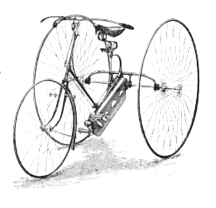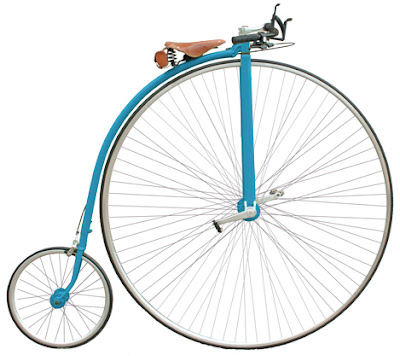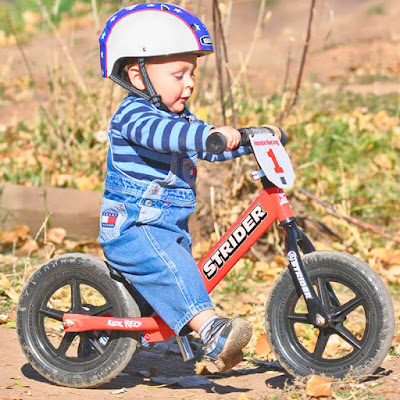Who Invented the Bicycle?
You might think that an
invention as simple as the bicycle would have an uncomplicated past. But as it
turns out, this highly popular invention has a history fraught with controversy
and misinformation. While stories about who invented the bicycle often
contradict one another, there's one thing that's certain — the very first
bicycles were nothing like the ones you see cruising down the street today.
The first known
iterations of a wheeled, human-powered vehicle were created long before the
bicycle became a practical form of transportation. In 1418, an Italian
engineer, Giovanni Fontana (or de la Fontana), constructed a human-powered
device consisting of four wheels and a loop of rope connected by gears,
according to the International Bicycle Fund (IBF).
In 1813, about 400 years after Fontana built his wheeled
contraption, a German aristocrat and inventor named Karl von Drais began work
on his own version of a Laufmaschine (running machine), a
four-wheeled, human-powered vehicle. Then in 1817, Drais debuted a
two-wheeled vehicle, known by many names throughout Europe, including
Draisienne, dandy horse and hobby horse. Our
current understanding of the history of the bicycle suggests that many people
contributed ideas and developments:
Chronology of the Growth of Bicycling and the Development of Bicycle Technology.1418 -Giovanni Fontana is credited with building the first human powered land vehicle -- it had four wheels and used an continuous rope, connected via gears to the wheels. Images and more detailed description don't seem to exist.
1493-Other bicycle histories websites include a sketches
1791- Comte de Sicrac is credited with building the "celerifer" - purportedly a hobby horse with two wheels instead of a rocker. This is now considered a patriotic hoax created by a French historian in 1891. It was debunked by a French researcher in 1976. In fact, a Jean Sievrac (!) of Marseille obtained an import price for a four-wheeled speed coach called celerifer in 1817.
Heinrich Mylius' bicycle, the Heimat Museum, Themar, Germany.
1817-Variously called the running machine, velocipede, Draisienne and dandy horse, it was invented by Karl Drais, in response to widespread starvation and the slaughtering of horses, the consequence of a crop failure the year before (caused by the eruption of Tambora). It had a steer-able front wheel. This is the first appearance of the two-wheeler principle that is basic to cycling and motorcycling and minimizes rolling resistance. The velocipedes were made entirely of wood and needed to be balanced by directing the front wheel a bit. People then did not dare to lift the feet off safe ground, therefore the velocipedes were propelled by pushing off with the feet. After the good harvest in 1817 riding velocipedes on sidewalks was forbidden worldwide, since the velocipeders used the sidewalks, and because they could not balance on the rutted carriageway, the fad passed. It took nearly 50 years, until a roller-skating boom created a new public with a better sense of balance.
1839-Another entry in bicycle lore: Kirkpatric Mcmillan, a Scottish blacksmith adapted a treadle-type pedals to a bicycle, is considered a hoax, see the David Herlihy's book.
1863-Bone Shaker or Velocipede: Made of stiff materials, straight angles and steel wheels make this bike literally a bone shaker to ride over the cobblestone roads of the day. The improvement is a front wheel with peddles -- direct drive, fixed gear, one speed. This machine was known as the velocipede ("fast foot"), but was popularly known as the bone shaker, They also became a fad, and indoor riding academies, similar to roller rinks, could be found in large cities.
1870-the high-wheel bicycle:The high-bicycle was the logical extension of the boneshaker, the front wheel enlarging to enable higher speeds (limited by the inside leg measurement of the rider), the rear wheel shrinking and the frame being made lighter. Frenchman Eugène Meyer is now regarded as the father of the high bicycle by the ICHC in place of James Starley. Meyer invented the wire-spoke tension wheel in 1869 and produced a classic high bicycle design until the 1880s.James Starley in Coventry added the tangent spokes and the mounting step to his famous bicycle named "Ariel." He is regarded as the father of the British cycling industry. Ball bearings, solid rubber tires and hollow-section steel frames became standard, reducing weight and making the ride much smoother. Depending on the rider's leg length, the front wheel could now have a diameter up to 60 in (1.5 m).This type of bicycle was retronymed the "ordinary" (since there was then no other kind) and was later nicknamed "penny-farthing" in England (a penny representing the front wheel, and a coin smaller in size and value, the farthing, representing the rear). They were fast, but unsafe. The rider was high up in the air and traveling at a great speed. If he hit a bad spot in the road he could easily be thrown over the front wheel and be seriously injured (two broken wrists were common, in attempts to break a fall) or even killed.Pope also introduced mechanization and mass production (later copied and adopted by Ford and General Motors), vertically integrated, (also later copied and adopted by Ford), advertised aggressively (as much as ten percent of all advertising in U.S. periodicals in 1898 was by bicycle makers), promoted the Good Roads Movement (which had the side benefit of acting as advertising, and of improving sales by providing more places to ride), and litigated on behalf of cyclists (It would, however, be Western Wheel Company of Chicago which would drastically reduce production costs by introducing stamping to the production process in place of machining, significantly reducing costs, and thus prices.) In addition, bicycle makers adopted the annual model change (later derided as planned obsolescence, and usually credited to General Motors), which proved very successful.Even so, bicycling remained the province of the urban well-to-do, and mainly men, until the 1890s, and was an example of conspicuous consumption.
1872-Friedrich Fischer (German) first mass-produces steel ball bearings, patented by Jules Suriray in 1869.
1876-Browett and Harrison (English) patent an early caliper brake.
1878-Scott and Phillott (English) patent the first practicable epicyclic change-speed gear fitted into the hub of a front-driving bicycle.The first American manufacturer of cycles begun with the Columbia Bicycle at the Weed Sewing Machine Company factory in Hartford, Ct. The first regular trade catalogue was twenty pages long. The first bicycles were the 60" High Wheelers and sold for $125.00 when sewing machines sold for $13.00.
1879-Henry J. Lawson (English) patents a rear wheel, chain-driven safety bicycle, the “Bicyclette” (his earlier models were lever driven).
1880-While the men were risking their necks on the high wheels, ladies, confined to their long skirts and corsets, could take a spin around the park on an adult tricycle. These machines also afforded more dignity to gentlemen such as doctors and clergymen. Many mechanical innovations now associated with the automobile were originally invented for tricycles. Rack and pinion steering, the differential, and band brakes, to name a few!
1884-Thomas Stevens struck out across the country, carrying socks, a spare shirt and a slicker that doubled as tent and bedroll. Leaving San Francisco at 8 o'clock on April 22, 1884, he traveled eastward, reaching Boston after 3700 wagon trail miles, to complete the first transcontinental bicycle ride on August 4, 1884. After a pause, he continued east, circumnavigating earth, and returning to San Francisco on Dec 24, 1886. See Around the World by Bicycle, 2000 reenactment of 1884 ride, and 2006reenactment of 1885 ride.
1890-Safety Bike: As the name implies the safety bike is safer than the ordinary. The further improvement of metallurgy sparked the next innovation, or rather return to previous design. With metal that was now strong enough to make a fine chain and sprocket small and light enough for a human being to power, the next design was a return to the original configuration of two same-size wheels, only now, instead of just one wheel circumference for every pedal turn, you could, through the gear ratios, have a speed the same as the huge high-wheel. Initially, the bicycles still had the hard rubber tires, and in the absence of the long, shock-absorbing spokes, the ride they provided was much more uncomfortable than any of the high-wheel designs. Many of these bicycles of 100 years ago had front and/or rear suspensions. These designs competed with each other, your choice being the high-wheel's comfort or the safety's safety, but the next innovation tolled the death of the high-wheel design -- pneumatic tires. This is basically the same design as standard contemporary bikes. The safety bike allowed large numbers of people to take up cycling. Bikes were relatively expensive so use was somewhat restrict to the elite.
1894-Change In Social Order: Betty Bloomer's bloomers become very popular. Ladies, heretofore consigned to riding the heavy adult size tricycles that were only practical for taking a turn around the park, now could ride a much more versatile machine and still keep their legs covered with long skirts. The bicycle craze killed the bustle and the corset, instituted "common-sense dressing" for women and increased their mobility considerably. American Music and women bicyclists. Women and bicycles.
1896-Let me tell you what I think of bicycling. I think it has done more to emancipate women than anything else in the world. I stand and rejoice every time I see a woman ride by on a wheel. It gives woman a feeling of freedom and self-reliance." Susan B Anthony.
1920-Kids Bikes: The focus of planning and development of the transportation infrastructure was the private automobiles. Bicycles use declined and the bicycle was considered primarily as children's toys. Kids bikes were introduced just after the First World War by several manufacturers, such as Mead, Sears Roebuck, and Montgomery Ward, to revitalize the bike industry (Schwinn made its big splash slightly later), these designs, now called "classic", featured automobile and motorcycle elements to appeal to kids who, presumably, would rather have a motor. If ever a bike needed a motor, this was it. These bikes evolved into the most glamorous, fabulous, ostentatious, heavy designs ever. It is unbelievable today that 14-year-old kids could do the tricks that we did on these 65 pound machines! They were built into the middle 50s, by which time they had taken on design elements of jet aircraft and even rockets. By the 60s, they were becoming leaner and simpler.
1930-Tullio Campagnolo patents the quick release hub.
1938-Simplex introduced their cable shifted derailleur.Historic European footage of unusual bikes from the late 1930s and early 1940s.
1950-Tullio Campagnolo introduced cable-operated, parallelogram derailleur. Campagnolo. For two decades Campagnolo equipment dominated true racing bikes. Eventually, he acquires 135 patents.
1958-Women ride in the first-ever World Championships on the road and track. Balina Ermolaeva becomes the first women's World Sprint Champion; Elsy Jacobs takes the road race.
1962-Renaissance: President's Council of Physical Fitness. Renewed interest in bicycle for recreation and fitness. This was the seed of a new major bicycle boom that accelerated through the 60's. The "English 3-speed" was the fancy consumer model of the time. Before the end of the decade it was the 10-speed derailleur "racing bike" which dominated the American market (the derailleur had been invented before the turn of the century and had been in more-or-less common use in Europe since).
1969-Audrey McElmury is the first American to wins the first World Road Cycling Championship, in Brno, Czechoslovakia, opening the door for American women to compete regularly in World Road cycling competition.
1970-Earth Day: Increased awareness of westerns civilization's level of consumption of natural resources, air pollution, and destruction of the natural environment. This generated a new spurt in the growth of bicycle sales and bicycling, especially around college campuses.
1973-Oil embargo: Fuel shortages and shifts in relative price of transportation options created an environment which encouraged bicycle commuting. Many of the new recruits to bicycling stuck to it after the end of the embargo and became enthusiasts. There was also reinvigorated interest in the engineering of bicycles, including renewed interest recumbents and fairings.
1977-The prototype of the mountain bikes were first developed in Marin Co, California, north of San Francisco. Joe Breeze, Otis Guy, Gary Fisher, and Craig Mitchell were the earliest designers, builders and promoters.
1984-Tour de France Feminine run for the first time (winner: Marianne Martin.).Women's road race included in the Olympics for the first time (winner: Connie Carpenter.) Successes by American racing cyclist in the 1984 Olympics drew attention and added prestige to cycling. The ranks of racing cyclists grew substantially.
1986-Department of the Interior and Nielson surveys show that bicycling is the third most popular participatory sport after swimming and general exercise.
1994-Sachs (SRAM) introduces PowerDisc, the first mass-produced hydraulic disc brake system.
1996-Mountain Bike compete at the Olympic Games for the first time in Atlanta, GA USA.
2000-Rohloff Speedhub 14 speed internal hub gearing system, with no overlapping ratios and a gear range as wide as a 27-speed derailleur system.
2002-Campagnolo introduces 10 cog rear cluster, allowing 30 speed bicycles.
2009-Shimano develops electronic gears that allow for faster shifting.
2012-The ADAPTRAC system is developed to allow riders to instantly inflate or deflate their tires while riding.
2014-Lithium Nickel Manganese Cobalt Oxide batteries gain popularity and may become the most used lithium battery for e-bikes.
8 Ways Cycling Will Make You Healthier.
1)Get Smarter
A study conducted by Charles Hillman back in 2007 showed that exercise boosts brainpower and helps to stave off Alzheimer’s in the elderly. That same year, Dr. Phil Tomporowski showed that kids are even more positively impacted by time on the bike—and that exercise can help control issues like ADD. (Read one cyclist's account of how riding helped him manage his ADHD.)
2)Improve Your Heart
Cycling is also great for your heart—although not just because you love riding so much (though that’s a great reason too!). A recent study in Medicine & Science in Sports & Exercise spent five years looking at the activity of 1,500 subjects. Those who were active on a daily basis were 31-percent less likely to develop high blood pressure.
3)Lose Fat
It shouldn’t really come as a surprise that weight loss is one of the big benefits of regular cycling, but it bears repeating. The media is often quick to promote the idea that diet is the only way to actually shed fat, but science is proving otherwise. A recent study showed that older, diabetic women could only drop visceral fat if exercise, along with diet, was introduced into their routine. The same was proved true for younger women.
4)Live Longer
According to one study of Tour de France riders from the past, cycling actually increased their longevity. On average, the former pros lived to 81.5 years compared to the general population’s 73.5 years: a 17-percent increase! Anther study suggested that even casual bike commuters benefit: For individuals who shift from car to bicycle, it was estimated that three to 14 months could be gained compared to the potential downsides of bike commuting.
5)Feel Better About Yourself
It’s no surprise that exercise in general (and cycling in particular) helps improve your self-esteem. The next time you take the perfect mid-ride selfie, score that Strava QOM you’ve been chasing, or finish a really hard workout, your body will release a whole bunch of feel-great hormones that will make you feel like you can take over the world.
6)Help Prevent Cancer
Maintaining a healthy weight, regular exercise, and a conscientious diet (think lots of leafy greens, lean proteins and healthy grains) all helps lower your risk of cancer. And a study published in the Journal of the American Medical Association recently looked at nearly 14,000 men and concluded that those with a higher fitness level as they approached middle age were at a lower risk for lung and colorectal cancer.
7)Feel Sexier
Best news ever: You aren’t the only one who thinks spandex is super hot. A survey of 600 men and women commissioned by The British Heart Foundation found that cyclists were perceived as 13-percent more intelligent and cooler than other people, and a whopping 23 percent said a cyclist would be their preferred blind-date athlete.
8)Recover From Injury
A recent study found that elderly patients with knee pain and osteoarthritis actually improved their condition when cycling was introduced to their routines, proving that as we get older, taking time to exercise—even just spinning a few minutes a day—can be hugely beneficial.
Riding a bike can help you lose weight, recover from injury, and even get smarter—and that's just for startersBibliography
1. Live science (by Elizabeth Palermo)August 29, 2017 10:30pm ET
2.Bicycle History&Human Powered Vehicle History (by David Mozer)
3. Evelo Electric Bicycles (https://www.evelo.com/history-of-the-bicycle/)
4.Bicycling (BYMAY 25, 2016
|










No comments:
Post a Comment